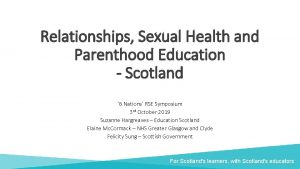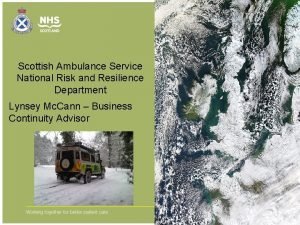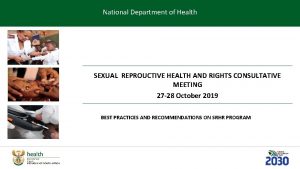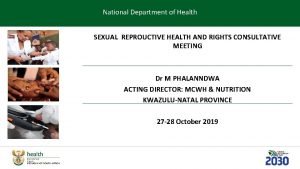National Department of Health SEXUAL REPROUCTIVE HEALTH AND



- Slides: 3

National Department of Health SEXUAL REPROUCTIVE HEALTH AND RIGHTS CONSULTATIVE MEETING 27 -28 October 2019

Safe abortion services and treatment of complications of unsafe abortion Partner Logo Name of Project Province/Districts covered Duration Enhancing the Ability of Women to Obtain Comprehensive Abortion Care and Prevent Unwanted Pregnancy Gauteng and Limpopo (25 GP, 35 LP) June 2017 – June 2020 (Current) Best Practices: • Partnership with DOH at national, provincial, district, and facility levels to strengthen health system capacity, quality, and ownership • Baseline assessment to provide contextual information for site selection • Renovate and equip public facilities and provide training for providers to support high-quality service provision for client choice • Community engagement to raise awareness and provide social support • Site-level stigma reduction and sensitization through whole site orientations (Values Clarification and Attitude Transformation) • Sustainability measures – Training of Trainers, clinical mentoring, refreshers, more than one provider per facility • Psychologist facilitated debriefing as providers feel overworked and burnt out • Integration of other SRH services in abortion care e. g. cervical screening, HIV testing etc. Results Achieved: • • • Lessons Learnt: • There is need to strengthen contraceptive counselling to ensure rights based approach and that providers are skilled in all methods • Access to SRH commodities relieves systemic problems and enhances client choice • Abortion stigma persists at all levels as a barrier to care • Creating enabling environments for both providers and clients at facility level through engagement with facility management (WSO strategy) • Community engagement for sensitization and awareness-raising • Need to increase awareness on CTOP Act and its amendment for communities • Need to expand 2 nd tri services and create a network of second tri providers • Need to increase overall # of TOP sites that are providing MVA and MA abortion care 5 days a week • Opportunity to incorporate CAC training in all mainstream nursing trainings including the Diploma in Advanced Midwifery • Obsolete practices being implemented in some facilities in 2 nd tri services e. g D&C • Adherence to policies and guidelines is a challenge 20 trainers and 20 clinical mentors have been trained and are supporting facilities in GP and LP with CAC & contraceptive training and clinical mentoring 62 providers have been trained on CAC and about 50% are currently providing services in facilities in GP and LP, doctors oriented on 2 nd tri MA From April 2018 to June 2019, 60 Ipas-supported facilities have provided a total of 27, 311 induced abortions, with 26, 742 (98%) clients receiving a form of post-abortion contraception excluding condoms, 34% (n=5, 886) elected long acting and reversible contraception (LARC) methods and a steady increase has been observed in the uptake of LARC over the course of the project 2

Safe abortion services and treatment of complications of unsafe abortion Partner Logo Name of Project Province/Districts covered Duration Developing and Testing Interventions to Address Use of Conscientious Objection Among Public Sector Health Care Workers to Address Women’s Access to safe, legal Abortion Services Gauteng, Limpopo, Eastern Cape and Kwa. Zulu Natal October 2018 – May 2020 (Current) Possible Best Practice: • Prototyping of user-centred interventions • Whole site orientation and training centered on conscientious objection • Provider selection criteria prior to TOP training and allocation to TOP unit • Provider support (debriefing sessions with managers, incentives and acknowledgement by management) • Improvement of facility TOP signage to direct clients Lessons Learnt: • Conscientious Objection is a poorly understood concept, even among those who invoke it • TOP service provision is highly stigmatized and misunderstood • Indecision and objection to TOP is mainly based on lack of awareness, myths and misconceptions, and religious beliefs • Lack of any formal procedures for staff to register their objection to TOP services delivery • Management support is crucial Way Forward: • Results dissemination is ongoing • Currently in second phase research, testing of interventions at facility level to note user inputs and modify interventions for improved outcomes 3





